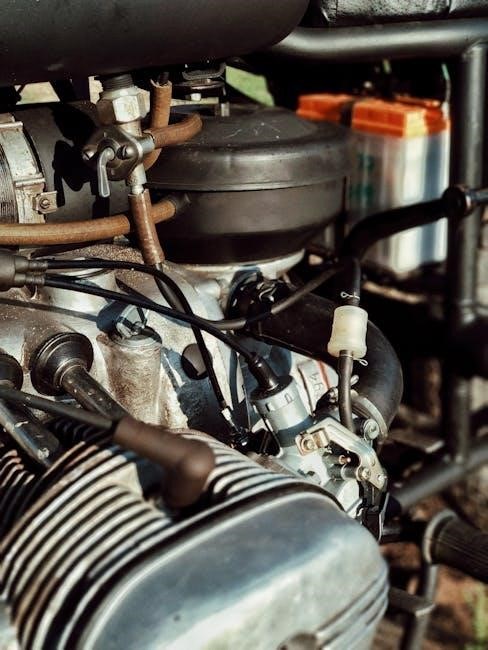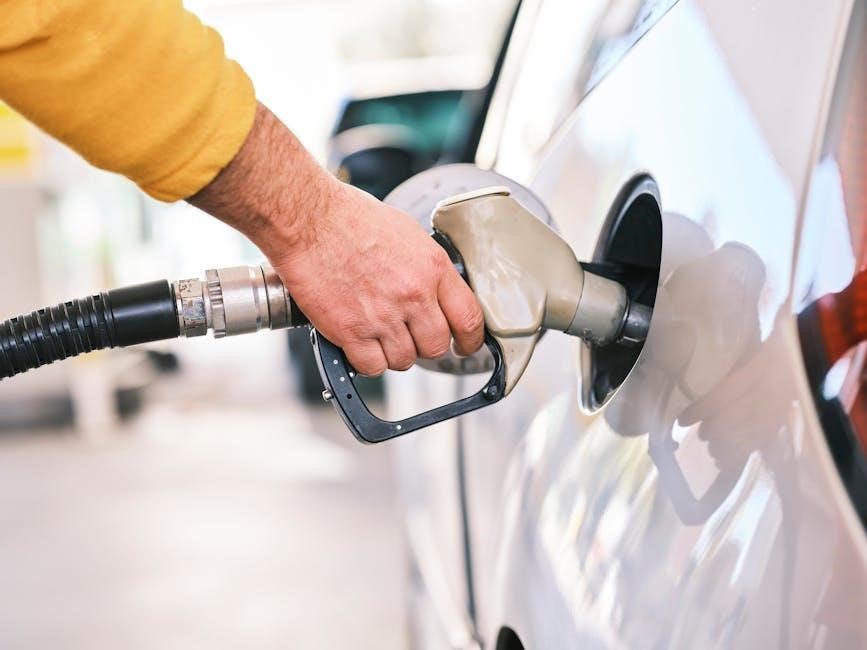Manual Fuel Pump: A Comprehensive Guide
This guide explores manual fuel pumps, detailing their types, applications, and working principles. It covers advantages, disadvantages, selection, and maintenance. This guide also emphasizes safety precautions. The aim is to provide a complete look at these components, which are used in various applications, from fuel transfer to older automotive systems.
What is a Manual Fuel Pump?
A manual fuel pump is a device used to transfer fuel from a tank to an engine or another system by hand. Unlike electric or mechanical pumps that rely on the engine’s power, a manual pump requires human effort to operate. These pumps are often found in older vehicles, machinery, or in situations where electricity is unavailable or unreliable. The primary function of a manual fuel pump is to prime the fuel system, ensuring that fuel reaches the engine quickly and efficiently.
Manual fuel pumps are designed to provide a reliable and straightforward method for fuel delivery. These pumps are often used in applications where simplicity and dependability are paramount. They are typically constructed with a handle or lever that, when operated, creates suction to draw fuel from the tank and then pushes it towards the engine. This process ensures that the carburetor or fuel injectors receive an adequate supply of fuel, enabling the engine to start and run smoothly.

Manual fuel pumps are particularly useful in situations where the fuel system has been drained or when starting an engine after a period of inactivity. By manually pumping fuel, the system can be primed, reducing the time and effort required to start the engine.
Types of Manual Fuel Pumps
Manual fuel pumps come in several designs, each suited for specific applications and fuel types. Piston pumps are a common type, using a piston moving within a cylinder to draw and expel fuel. These are often used for higher-viscosity fuels due to their strong suction capabilities. Diaphragm pumps are another prevalent type, employing a flexible diaphragm that moves back and forth to create a pumping action. They are suitable for lower-viscosity fuels and are known for their reliability.
Rotary vane pumps use a rotating mechanism with vanes that create chambers to move the fuel. These pumps are efficient and can handle moderate fuel viscosities. Siphon pumps rely on gravity and atmospheric pressure to transfer fuel, typically involving a hose and a hand-operated bulb to initiate the siphon. These are simple and require no mechanical parts, making them ideal for emergency fuel transfer.
Each type offers unique advantages depending on the fuel type, flow rate, and application requirements. Selecting the correct pump ensures efficient and safe fuel transfer, whether for automotive, marine, or industrial uses. The choice depends on factors like fuel compatibility, ease of use, and durability.

Applications of Manual Fuel Pumps
Manual fuel pumps find widespread use across various sectors due to their simplicity and reliability. In automotive applications, they are frequently used to prime the fuel system in older vehicles, particularly those with carburetors. This ensures that fuel reaches the engine quickly, aiding in starting after periods of inactivity or when the fuel lines have been drained. They are also invaluable in emergency situations, such as when an electric fuel pump fails, providing a backup method to transfer fuel.
In marine settings, manual fuel pumps are crucial for transferring fuel to smaller engines, like those in boats and generators. They are also used for draining fuel tanks during maintenance or repairs. Agricultural machinery often relies on manual pumps for transferring fuel to tractors and other equipment in remote locations where electricity is unavailable. Industrial applications include transferring various liquids, not just fuel, in processes where precise flow control and portability are essential.
Furthermore, manual fuel pumps are used in home settings for tasks like siphoning fuel from storage containers to lawnmowers or other small engines, highlighting their versatility and practical utility in diverse environments. Their ease of use and lack of reliance on electrical power make them indispensable in scenarios requiring dependable fuel transfer solutions.
Working Principle of a Manual Fuel Pump
The working principle of a manual fuel pump relies on creating suction and pressure through mechanical action, typically using a lever or handle. When the lever is operated, it moves a diaphragm or piston within the pump chamber. As the diaphragm or piston moves in one direction, it increases the volume of the chamber, creating a vacuum. This vacuum draws fuel from the fuel tank through an inlet valve, filling the chamber. The inlet valve prevents fuel from flowing back into the tank.
When the lever is moved in the opposite direction, it decreases the volume of the chamber, creating pressure. This pressure forces the fuel out through an outlet valve towards the engine or fuel system. The outlet valve ensures that the fuel flows in only one direction, preventing it from returning to the pump chamber. This reciprocating motion of the diaphragm or piston, combined with the check valves, allows the manual fuel pump to efficiently transfer fuel from the tank to the desired location. The simple yet effective design makes manual fuel pumps reliable and easy to maintain.
Overall, the manual operation leverages basic physics to ensure fuel delivery even without electrical assistance.
Mechanical Fuel Pumps: How They Work
Mechanical fuel pumps, commonly found in older vehicles with carburetors, operate through a direct mechanical linkage to the engine. Typically driven by the engine’s camshaft or crankshaft, these pumps use a diaphragm to create suction and pressure. A lobe on the camshaft pushes an arm connected to the diaphragm, causing it to move up and down. As the diaphragm moves downward, it increases the volume in the pump chamber, creating a vacuum that draws fuel from the tank through the fuel lines and a fuel filter.
When the camshaft lobe rotates away, a spring pushes the diaphragm upward, decreasing the chamber’s volume and pressurizing the fuel. This pressurized fuel is then forced through an outlet valve towards the carburetor. Check valves at both the inlet and outlet prevent backflow, ensuring a one-way flow of fuel. The pump only refills the chamber as needed, based on the engine’s fuel demand, thanks to the spring and lever mechanism. This design provides a simple and reliable way to supply fuel to the engine without electrical components, making it a staple in older automotive technology.
The mechanical fuel pump is a robust solution for fuel delivery.
The Diaphragm’s Role in Mechanical Pumps
The diaphragm is the central component in a mechanical fuel pump, responsible for creating the necessary suction and pressure to move fuel from the tank to the engine. Typically made of a flexible, fuel-resistant material like rubber or synthetic polymer, the diaphragm is housed within the pump body and connected to a mechanical linkage. This linkage is usually driven by the engine’s camshaft or crankshaft, causing the diaphragm to move up and down.
As the diaphragm moves downward, it increases the volume of the pump chamber, creating a vacuum. This vacuum draws fuel from the fuel tank, through the fuel lines, and into the chamber. When the diaphragm moves upward, driven by a spring, it decreases the chamber’s volume, pressurizing the fuel. This pressurized fuel is then forced out of the pump and towards the carburetor or fuel injection system. The diaphragm’s flexibility allows it to create a tight seal, preventing leaks and ensuring efficient fuel transfer.
The diaphragm’s consistent and reliable performance is crucial for maintaining a steady fuel supply to the engine, particularly in older vehicles that rely on mechanical fuel pumps.
Advantages of Using a Manual Fuel Pump
Manual fuel pumps offer several advantages, particularly in specific applications; One key benefit is their simplicity and reliability. With fewer moving parts compared to electric pumps, manual pumps are less prone to mechanical failure and can operate in conditions where electrical power is unavailable or unreliable. This makes them ideal for use in remote locations or in vehicles and equipment that are not frequently used.
Another advantage is their ease of maintenance and repair. Manual fuel pumps are generally straightforward to disassemble and clean, and replacement parts are often readily available and inexpensive. This can result in lower long-term operating costs compared to electric pumps, which may require specialized tools or expertise to repair.
Manual fuel pumps also provide a direct and immediate means of priming the fuel system. This is particularly useful in situations where the fuel lines have been drained or when starting an engine after a period of inactivity. By manually pumping fuel, the system can be quickly filled, ensuring a faster and more reliable start. Their robust design and operational simplicity make them a practical choice for various applications.
Disadvantages of Using a Manual Fuel Pump
Despite their advantages, manual fuel pumps also have several drawbacks that limit their applicability in certain situations. One primary disadvantage is the manual effort required for operation. Unlike electric pumps, which can continuously supply fuel, manual pumps require physical pumping to maintain fuel flow. This can be tiring and impractical for applications requiring a constant and high fuel supply.
Another limitation is their lower fuel delivery rate compared to electric pumps. Manual pumps are designed to provide a steady but relatively low volume of fuel, which may not be sufficient for high-performance engines or applications with high fuel consumption. This can result in reduced engine performance or operational inefficiencies.
Manual fuel pumps also lack the automation and control features of electric pumps. They cannot be easily integrated with electronic fuel injection systems or other advanced engine management technologies. This limits their use in modern vehicles and equipment that rely on precise fuel delivery and control. Furthermore, manual pumps are more susceptible to human error, as the operator must manually regulate the fuel flow. This can lead to inconsistent performance or potential fuel wastage. These limitations make them less suitable for applications requiring high fuel volumes or automated control.
Selection Criteria for Manual Fuel Pumps
Choosing the right manual fuel pump involves considering several key factors to ensure optimal performance and reliability. The first consideration should be the required fuel flow rate. Determine the amount of fuel needed for the application to ensure the pump can deliver an adequate supply. The pump’s material construction is also critical; opt for durable materials like aluminum or stainless steel to withstand the corrosive nature of fuels and ensure longevity.
Compatibility with the type of fuel being used is another essential criterion. Different fuels have varying properties, and the pump must be designed to handle the specific fuel without degradation or failure. Consider the pump’s design and ease of installation. A user-friendly design will simplify the setup process and reduce the risk of errors.
Check the pump’s pressure rating to match the system’s requirements. An appropriate pressure rating ensures efficient fuel delivery without over-pressurizing the system. Evaluate the pump’s overall build quality and reliability. A well-built pump will minimize the need for frequent maintenance and replacement. Finally, consider the cost and availability of spare parts. Opting for a pump with readily available parts can save time and money in the long run, ensuring continued operation and minimizing downtime. Taking these factors into account will help in selecting the most suitable manual fuel pump.
Maintenance of Manual Fuel Pumps
Maintaining a manual fuel pump is essential for ensuring its longevity and reliable performance. Regular inspections are crucial; check for any signs of wear, leaks, or damage to the pump body, hoses, and connections. Address any issues promptly to prevent further complications. Periodically clean the fuel pump and its components to remove dirt, debris, and fuel residue that can accumulate over time.
Use a suitable solvent or cleaner to avoid damaging the pump’s materials. Lubricate moving parts, such as the pump handle and linkages, with appropriate lubricant to ensure smooth operation and prevent corrosion. Inspect and replace fuel filters regularly to prevent contaminants from entering the pump and causing damage. Check fuel lines for cracks, kinks, or leaks and replace them as needed to maintain proper fuel flow and prevent fuel wastage.
If the pump has a diaphragm, inspect it for any signs of wear or damage and replace it if necessary. Store the fuel pump in a clean, dry place when not in use to protect it from environmental elements that can cause corrosion or deterioration. Follow the manufacturer’s recommendations for specific maintenance procedures and schedules to ensure optimal performance and longevity. By adhering to a regular maintenance routine, you can prolong the lifespan of your manual fuel pump and ensure it operates efficiently whenever needed.
Safety Precautions When Using Manual Fuel Pumps
When operating manual fuel pumps, prioritizing safety is paramount to prevent accidents and injuries. Always work in a well-ventilated area to avoid inhaling harmful fuel vapors, which can cause dizziness, nausea, or even loss of consciousness. Wear appropriate personal protective equipment (PPE), including gloves and eye protection, to minimize exposure to fuel and prevent skin or eye irritation. Ensure the fuel pump is properly grounded to prevent static electricity buildup, which can ignite flammable fuel vapors.
Never smoke or use open flames near the fuel pump or fuel containers, as these can easily ignite fuel vapors and cause a fire or explosion. Use only approved fuel containers that are designed for storing and transporting fuel safely. Avoid overfilling fuel containers, as this can lead to spills and increase the risk of fire or environmental contamination. When transferring fuel, keep a safe distance from potential ignition sources, such as running engines or electrical equipment.
In the event of a fuel spill, immediately clean it up using absorbent materials and dispose of them properly. Store fuel in a secure location away from heat, sparks, and other potential ignition sources. Regularly inspect the fuel pump and its components for leaks, damage, or wear and tear. If you notice any issues, address them promptly to prevent accidents or equipment failure. By following these safety precautions, you can minimize the risks associated with using manual fuel pumps and ensure a safe working environment.

Troubleshooting Common Issues

Manual fuel pumps, while reliable, can sometimes encounter issues that prevent them from functioning correctly. One common problem is a lack of fuel flow; This could be due to a clogged fuel filter, which restricts fuel from reaching the pump. Inspect the filter and replace it if necessary. Another cause could be a blocked fuel line. Check for kinks, bends, or obstructions in the fuel line and clear them to restore proper fuel flow.
Air leaks in the fuel line can also cause problems. Inspect all connections and fittings to ensure they are tight and secure. If you suspect a leak, apply soapy water to the connections and look for bubbles, which indicate an air leak. Replace any damaged or worn-out fuel lines to prevent air from entering the system.
A worn or damaged pump diaphragm can also lead to fuel pump failure. Inspect the diaphragm for cracks, tears, or other signs of wear and tear. If the diaphragm is damaged, replace the entire fuel pump assembly. Additionally, a faulty check valve can prevent the pump from building pressure. Clean or replace the check valve to ensure proper fuel flow. If you encounter any of these issues, systematically troubleshoot the fuel pump and its components to identify and resolve the problem.
Manual fuel pumps, while seemingly simple in design, play a crucial role in various applications. From priming engines to transferring fluids in remote locations, their reliability and ease of use make them invaluable tools. Throughout this guide, we have explored the different types of manual fuel pumps, their working principles, and their advantages and disadvantages. We’ve also delved into the selection criteria, maintenance procedures, and safety precautions necessary for their proper operation.
Understanding the nuances of manual fuel pumps empowers users to make informed decisions when selecting, using, and maintaining these devices. Whether you’re a seasoned mechanic, a DIY enthusiast, or simply someone seeking a reliable fluid transfer solution, the knowledge gained from this guide will serve you well. By adhering to the recommended maintenance practices and safety protocols, you can ensure the longevity and efficient performance of your manual fuel pump.





